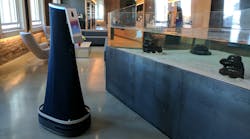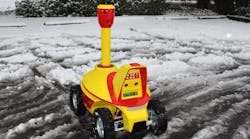My Point of View: Humanoid Robots Walk Among Us –Well, Sort Of
Advanced humanoid robots. It sounds like the title of a 1950s sci-fi movie starring James Arness. For those of you too young to know who that is, think Marshall Matt Dillon and television’s Gunsmoke. If you still don’t know, look it up. But I digress
The concept of human-looking robots has been around for decades. As the robotics industry evolved, its main thrust was in manufacturing and industrial applications that involved hinged-arm devices that grabbed, welded, drilled, polished and sorted all types of raw products along an assembly line. The auto industry was revolutionized by robotics, while other markets like healthcare, logistics and hospitality have also been impacted. But the development of functional humanoid robots that had applications in other sectors has been measured.
Many of the advanced versions of humanoid robots are still in development or beta testing, but as the science matures, we are seeing these machines move from lab rats to the real world as bartenders, concierges, deep-sea divers and as companions for older adults, while others are working in warehouses and factories, assisting humans in logistics and manufacturing, according to the website built-in.
The research firm MarketsandMarkets says the humanoid robotic market is valued at $1.5 billion in 2022 and is predicted to skyrocket to more than $17 billion in the next five years.
So, it is no surprise that the security industry is moving forward with developing its own market for humanoid robots. As built-in says: “It’s unclear how well humanoid robots will integrate within society and how well humans will accept their help. While some people will see the proliferation of these robots as creepy, dangerous or as unneeded competition in the labor market, the potential benefits like increased efficiency and safety may outweigh many of the perceived consequences.”
If those potential clients in the security market can move beyond the “creep-out” factor, innovative applications are being rolled out by major players like ADT, with the window for more intricate adoption seeming to be wide open.
“About two and a half years ago, ADT began looking at some of the industry chronic issues that were plaguing companies -- one being guard shortages, which is still a problem today. We began to investigate if there was a place that ADT can play in that space,” said William Plante, ASP ITIL, who is the Director of eSRG Consulting Services and Strategic Development at ADT Commercial, during a conversation we had at the recent GSX security event in Atlanta. “We started looking at emerging technologies. And we quickly discovered, yes, there is an interest in emerging technologies, specifically around how to fulfill the guard gap given the current labor shortage. In doing some whiteboarding around all of that, we decided, yes, the two technologies that we see as a driving force {in guard applications} is in drones, both indoor and outdoor, and human robotics.”
Mike Lavway, CPP, who is the Director of eSRG Operations with ADT, walked through a performance from the company’s newest representative with me in Atlanta. ADT partnered with Halodi Robotics, a Norway-based supplier of humanoid robotic solutions in physical security, retail and healthcare applications, with the goal of providing a human-like guard solution that could provide better situational awareness. The robot was introduced at GSX Dallas last year.
“The robotics platform that we're using right now has a human form. It has a head, it has shoulders, it has arms, and it can mimic human movements. So now, connected through a headset, you can perform the physical tasks of a security officer from anywhere. Now we can fill the gap William was talking about in the guarding industry with humanoid robotics from afar, if you will, using robotics to do it,” explained Lavway, adding that the ADT version extends beyond clunky pear-shaped robotic guards.
“Those other robots, they can patrol, they can observe, and they can report. However, our robot can actually engage. So, this robot can open a door, this robot has hands so it can actually manipulate its environment. If it sees a box in front of an emergency exit, it can physically move the box, while actually engaging in real-time with its environment, as opposed to just driving around until it sees something and then keeps driving.”
Technologist like Plante and Lavway are confident that humanoid robots are poised to have a tremendous impact in the industrial and commercial security space, and as AI and machine learning software continues to advance there are literally no limits to future development.
To quote a pioneering humanoid robot, Gort: “Klaatu barada nikto.”
Again, if you don’t know that one either, look it up!





